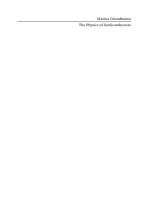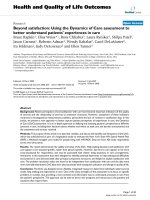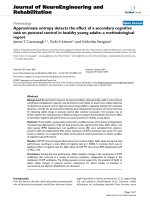Evaluating objectively the result of teaching practice of fourth year students, faculty of pedagogy, an giang university at high schools in an giang province
Bạn đang xem bản rút gọn của tài liệu. Xem và tải ngay bản đầy đủ của tài liệu tại đây (120.8 KB, 4 trang )
DALARNA UNIVERSITY, SWEDEN
AND FACULTY OF PEDAGOGY, VIETNAM NATIONAL UNIVERSITY, HANOI
Education Thesis
EVALUATING OBJECTIVELY THE RESULT
OF
TEACHING PRACTICE OF FOURTH
YEAR STUDENTS, FACULTY OF PEDAGOGY,
AN GIANG UNIVERSITY AT HIGH SCHOOLS
IN AN GIANG PROVINCE.
MA. NGUYỄN BÁCH THẮNG
SUMMARY OF DISSERTATION
Educational innovation derives from renovating the teachers’ teaching methods. The
internship process is a key factor in deciding whether a student has the necessary ability
to teach or not. Thus, the quality improvement of internship is the issue that many
schools of education and faculty of pedagogy have to consider and carry out in the future.
In order to train a good teacher, besides training for their major subjects, the process of
internship needs to make students love and have much passion for their teaching career.
The universities, institutions, faculties of education, high schools and each student of
pedagogy is obligated to make great efforts to improve his/her knowledge and improve
the quality of the internship.
Nowadays, the whole nation is implementing innovations in content, programs and
teaching methods in all levels of school - from the kindergarten to university. The
innovation of teaching and learning style has been taking place in universities and high
schools. Also, the MOET organizes such training courses for schools and universities
annually. Therefore the students can learn and apply new teaching approaches more
actively during their time as interns or student teachers at high schools.1
While performing their internship at high schools, the trainees can apply the knowledge
and the methods they had studied onto “the real learners”- that is high school students.
´Real´ high school students differ from their classmates who play the role of high school
students performed in stage one at the university. There are obviously some new
pedagogical situations at the high school such as nurturing excellent students, tutoring
1
weak students, re-teaching naughty and stubborn students, contacting students’ parents
and attending the teaching professional-discussion activity at the high school. The
MOET also wants to know whether the young new teachers are able to use new teaching
methodologies.
The thesis “Evaluating objectively the result of teaching practice of fourth year
students, faculty of pedagogy, An Giang University at high schools in An Giang
province” aims to devise a system to evaluate students when they practice teaching at
high schools, to help the Executive Board of An Giang University understand the
teaching and learning situation of teachers and students at the University. Based on the
findings, the Executive Board will give suitable suggestions to improve the quality of
teaching at the University as well as the quality of teaching practice in the next years. For
that reason, I have raised the following question to study.
Based on theories, methods and evaluation instruments applied in the project, we can
evaluate objectively the result of teaching practice. As a first step, we can classify the
teaching quality of trainees in their teaching practice at high school..
My dissertation includes 6 chapters: chapter I: Diagnosis; chapter II: Purpose; chapter III:
Theory; chapter IV: Method; chapter V: Action; chapter VI: Evaluation
Chapter I – Diagnosis: Introduce the history of An Giang University, the matters need to
be studied when students practice teaching at high schools. As a member of the
Executive Board of the teaching practice phase of An Giang University, I directly
participate in the teaching practice of the students. Through previous reports of teaching
practice, interviews of Executive Board of teaching practice phase at high schools,
teaching trainers and trainees at high school, I discovered several problems in the
organization of teaching practice and the evaluation procedure of students’ teaching
practice as follows:
First, the relationship between the Executive Board of teaching practice at An Giang
University and the Executive Board of teaching practice at high schools was not
organized or strong enough. Most data on teaching practice were collected from the
leaders of high school teaching practice. Also, the distribution of teacher-students to
various high schools was not suitable. For example, some schools were provided more
teacher- students than they needed. As a result, the supervisors in these schools didn’t
have enough time to supervise their number of teacher-students to be supervised or offer
remarks and evaluations for their teacher-students.
2
Second, very few An Giang University teachers took part in classroom observations at
high schools nor did they sit down with high school teaching trainers to discuss and
evaluate the students’ work. Most of such discussion and evaluation was given to the
high school teaching supervisors.
Third, each high school evaluated the teaching practice result differently. The evaluation
standard was subjective and depended on the high school management board and
teaching trainers there. As a result, there were great differences in evaluating teaching
practice among the participating high schools.
Fourth, a large number of the trainees did their teaching practice tasks at their old high
schools. According to the data collected from interviews of last year’s trainees, teachers
in those high schools had a tendency to give higher scores for his/her old students.
Additionally, most trainees only knew their teaching practice results at the end of
teaching practice tasks, so they had very few occasions to discuss their ideas about the
evaluation with the supervisors.
Last but not least, some leaders of teaching practice high schools were not really able to
watch the students; they seldom participated in their students’ teaching periods. For this
reason, they did not feel responsible for evaluating the trainees´ performance.
Chapter II – Purpose: Mention about the importance, aims, targets of the project and
beneficiaries from the project.
Chapter III – Theory: Summarize some applied theories to study the project, interpret
some vocabularies in teaching practice, and summarize some articles about teaching
practice of authors in meetings related to the studied project.
Chapter IV – Method: Present the methods used in the study, summarize the strong and
weak points. Combine all the methods together when studying to obtain the highest result
to implement the project. Summarize the steps to execute the project.
Chapter V – Action: In order to answer the first question, we assign the responsibility of
members who take part in evaluating teaching practice, divide teaching practice groups
according to the proposal of schools. In order to answer the second question, we use
assessment instruments and improve the methods of assessment to evaluate the teaching
practice of students. Then, we synthesize and analyze the results, point out the backlog
matters and offer some solutions for the next phase of teaching practice.
3
Chapter VI – Evaluation: Reevaluate the project implementation process, point out
the improvement of relationships and mission among members who take part in the
process of teaching practice, point out the improvements between the old and
innovated evaluation methods. Bring out opinions of participants in the project on the
innovated evaluation method. The result will be able to allow the project to be studied
in the next phase of teaching practice in order to perfect objectively evaluation
procedures of the students teaching practice results step by step. Withdraw some
practical values that we may learn from the project.
. Values drawn from the project:
a. My project was implemented in 8 weeks at high schools. In these eight weeks, we
objectively assessed the teaching practice quality of teaching practice students. When
implementing the project, I find that assigning the task and defining the close
relationship among sides participating in assessing make the assessment result of
students more objective.
b. Leader and manager need know how to mobilize the existing external and internal
force, how to combine them together to make the project implementation attain better
results.
c. Leader and manager need to hear the feedback from different sides and analyze the
information and make the adjustments which are suited to the reality happening at
high school.
d. Leaders need to concentrate on strategic activities, bring out actual programs and
authorize members to implement, carry out checking and controlling the level of
work completion of authorized members.
e. The project pays attention to the time of activity, people attending the project, project
implementation budget in order to ensure that the project implementation will reach
the highest result with the lowest expense.
f. After finishing the project, the leaders know how to self assess good points and
drawbacks of the project, know how to acknowledge weak points in order to find out
the next solutions.
In short, through researching the project, I have learnt that if I want to become a good
leader, I must know how to self evaluate my strong points and limitations, know how to
recognize my weak points and find out the way to overcome; always paying attention to
activities which no one can solve. Assigning is a time management model, carrying out
control right and completing the responsibility effectively, simultaneously developing the
necessary skills of the staff; always exerting ourselves to put the quality on the top,
utilizing the chances to learn from the experience of colleagues and students.
4









